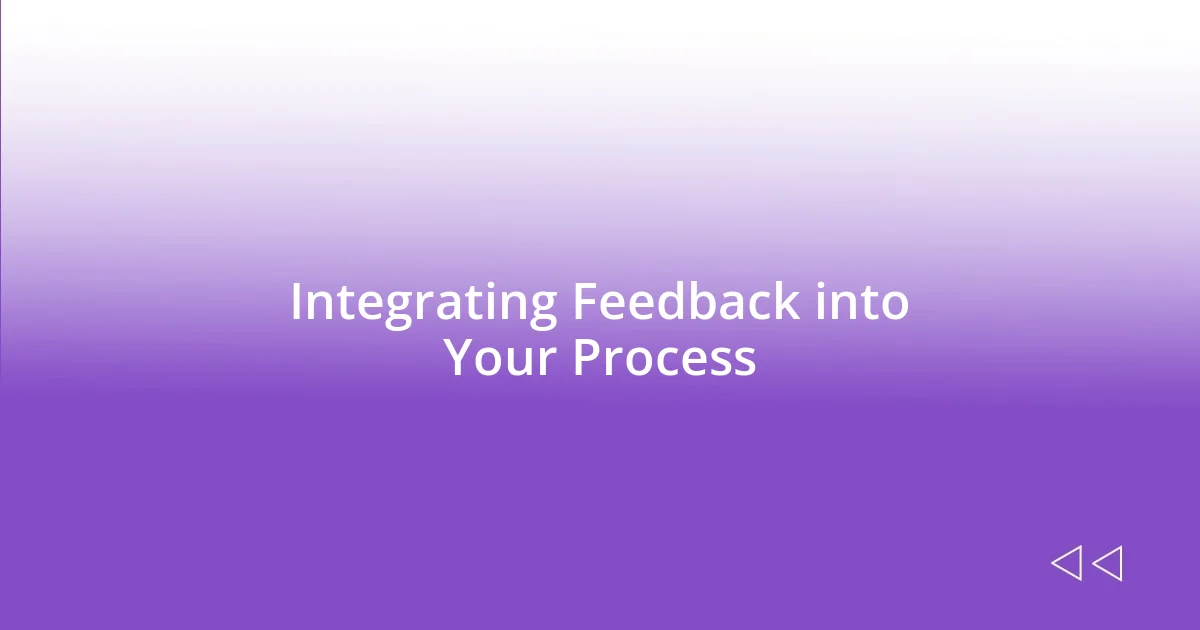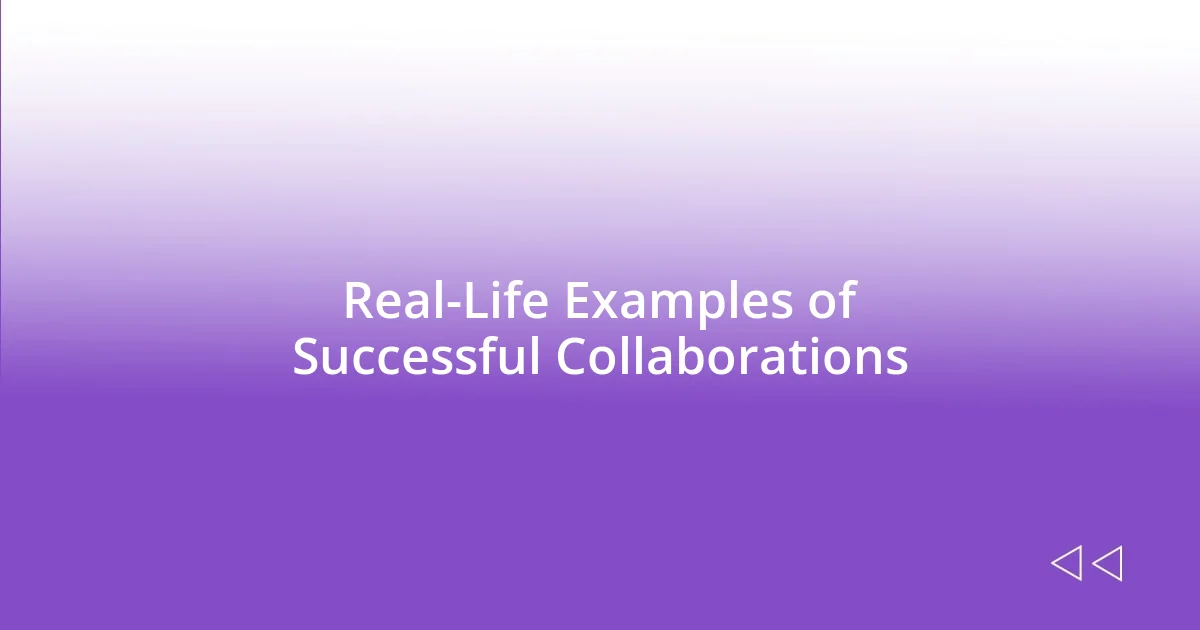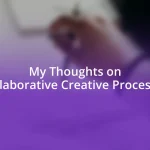Key takeaways:
- Collaboration enhances creativity by introducing diverse perspectives, leading to new ideas and emotional depth in songwriting.
- Finding the right collaborators involves shared vision, complementary skills, and emotional connection, which foster a productive and enjoyable creative environment.
- Successful collaborations, such as those between Ed Sheeran and Justin Bieber, demonstrate the power of merging distinct styles to create impactful music that resonates with broader audiences.

Understanding the Power of Collaboration
When I think about collaboration, I can’t help but recall a particularly memorable night jamming with a few fellow songwriters. The energy in the room was electric; our ideas bounced off each other like musical notes. Isn’t it fascinating how a simple conversation can morph into something larger than the sum of its parts?
Collaborating often leads me to explore themes and narratives I wouldn’t necessarily have considered on my own. For instance, when I teamed up with a friend who had a unique perspective on loss, it opened up a whole new emotional depth in my songwriting. It made me wonder: how often do we limit ourselves by sticking to our own experiences?
There’s an undeniable magic that happens when you blend different perspectives in a song. I remember feeling a rush of inspiration when a co-writer suggested an unexpected twist in the bridge of a track we were working on. That moment made me realize collaboration isn’t just about merging ideas; it’s a transformational process that can elevate our work to places we never thought possible.

Benefits of Collaborating with Others
Working with others not only shares the workload but also brings an array of new ideas and styles to the table. I’ve experienced a situation where my guitar-playing buddy introduced a fresh chord progression that completely altered the vibe of our song. This collaboration allowed me to step outside my comfort zone, showcasing how collaboration can enrich and diversify the creative process.
Another benefit I’ve found is the supportive environment that often comes with collaboration. I’ve been in sessions where, amidst laughter and brainstorming, I’ve received constructive criticism that shaped my lyrics significantly. That experience reinforced my belief that joint efforts can foster encouragement, helping us push boundaries we might otherwise shy away from.
Finally, I believe collaboration often builds strong relationships that can last beyond a single project. I still remember the first time I co-wrote a song with someone I barely knew. What started as a casual session transformed into a friendship and a continued creative partnership. In my experience, these lasting connections not only enhance our artistic journey but also lead to opportunities we may not have encountered alone.
| Benefit | Description |
|---|---|
| New Ideas | Collaboration introduces diverse perspectives that can inspire fresh ideas and techniques. |
| Supportive Environment | Collaborating with others often leads to constructive feedback and encouragement. |
| Lasting Relationships | Working together fosters friendships that can result in ongoing creative partnerships. |

Finding the Right Collaborators
Finding the right collaborators is crucial for a fruitful songwriting process. I’ve learned that chemistry between partners can make a world of difference. For example, during a session with someone I had initially considered a potential collaborator, we hit an unexpected roadblock. It was a bit awkward, and we both left feeling uninspired. That experience taught me to trust my instincts—finding someone who not only complements my style but also shares a similar vibe is essential.
Here are some key factors I consider when looking for collaborators:
- Shared Vision: It’s vital that we have a common goal for the project. That alignment can spark magic in the creative process.
- Complementary Skills: I look for someone whose strengths offset my weaknesses, whether it’s in melody, lyrics, or instrumentation.
- Emotional Connection: A collaborator should resonate with me on a personal level. I remember the warmth that enveloped me when I worked with someone who understood my story.
- Open-Mindedness: Flexibility is key. I truly value collaborators who are willing to explore different ideas and take risks with our music.
- Positive Energy: Working with someone who brings a cheerful attitude can create an atmosphere that’s not only productive but also enjoyable.

Techniques for Effective Songwriting Sessions
When it comes to effective songwriting sessions, I’ve found that setting clear intentions can significantly enhance our productivity. Before diving into the music, I often suggest we share what we each hope to achieve in that session. This simple step can keep us aligned and energized, preventing off-topic discussions that can easily derail our flow. Have you ever been in a session where time seemed to slip away because no one was on the same page? I certainly have, and it can be frustrating!
Another technique that works wonders is creating an open space for brainstorming. To foster a genuinely collaborative environment, I make it a point to encourage wild ideas without judgment. One memorable session revolved around adding unexpected sounds—like incorporating my friend’s beatboxing into our melody. The laughs and surprises that arose brought us closer and sparked ideas we might not have considered alone. It’s amazing how silly moments can lead to profound creativity.
Lastly, a change of scenery can provide a much-needed boost. Whether it’s heading to a cozy café or just moving to a different room, I really believe that sometimes, a fresh environment ignites new inspiration. I recall a day when we simply stepped outside to write in the park. The breeze and chirping birds filled our session with energy, resulting in lyrics that captured the beauty of the moment. So, have you ever switched up your location for creative work? If not, it might be worth a try!

Integrating Feedback into Your Process
Integrating feedback into my songwriting process has proven invaluable over time. I remember a particular moment when a trusted collaborator shared that a verse felt too rushed. At first, I was defensive, but their observation sparked a realization—I hadn’t given that part the careful thought it deserved. This feedback not only transformed that song but also deepened my trust in collaborative efforts. Recognizing the value of such insights can truly elevate the final product.
Another aspect I cherish is the gut feeling I get when receiving feedback. It’s not just about the words; it’s about the tone and delivery. Once, a collaborator responded to a hook I was proud of with a simple “Hmm, I’m not sure.” Rather than dismissing it, I probed deeper and learned they felt it lacked uniqueness. It was this vulnerability that opened the door to a richer discussion and ultimately led us to create a hook that set the song apart. How often do we let our emotions guide us in these moments of critique?
I’ll always advocate for feedback that feels safe and constructive. During one memorable session, we created a “feedback sandwich” approach—beginning with a positive note, layering in constructive criticism, and closing with another compliment. This method fostered a nurturing environment, allowing us to explore ideas freely. Have you tried something similar? It dramatically shifted our dynamics, making the process not just productive but genuinely enjoyable, creating a space where every voice feels heard and valued.

How to Maintain Creative Control
Maintaining creative control while collaborating can feel like a balancing act. I often remind myself that it’s integral to assert my vision, especially when it’s close to my heart. For instance, during a session, I had a melody in mind that I absolutely loved. When a collaborator suggested altering it, I took a moment to express why that specific melody resonated with me. It’s important to advocate for your ideas while allowing space for input, which can lead to a richer outcome.
One technique I use is establishing boundaries at the start of the collaboration. I once worked with a talented writer who had a vastly different style than mine. To keep our creative paths aligned, we decided on specific themes and lyrical structures before diving in. This way, I felt more comfortable taking risks, knowing I was still steering the ship. Have you ever tried setting clear guidelines? It truly allows the creativity to flourish without straying too far from your core vision.
In many instances, it boils down to trusting your instincts. I recall a moment when a collaborator pushed for a direction I wasn’t passionate about. Instead of yielding, I took a breath and shared my concerns. Voicing what inspires me led us to discover a new style that integrated both our visions while keeping my creative spirit intact. How often do we allow ourselves to voice hesitations? I believe honesty is crucial for maintaining that precious creative control.

Real-Life Examples of Successful Collaborations
One of the most striking examples of successful collaboration in songwriting that comes to mind is the partnership between Ed Sheeran and Justin Bieber on “I Don’t Care.” Their synergy brought together two distinct styles, merging Sheeran’s melodic sensibility with Bieber’s rhythmic flair. I remember listening to it for the first time and being struck by how their voices complemented each other, creating a catchy yet deeply relatable anthem about feeling out of place. Isn’t it fascinating how two creative minds can elevate a song beyond what either could achieve alone?
Another inspiring collaboration is between Dua Lipa and Elton John on “Cold Heart.” This track beautifully blends Lipa’s modern pop vibe with John’s classic sound, making it a chart-topping success. It’s incredible to see how they adapted and reimagined John’s timeless melodies, breathing fresh life into them. Have you ever thought about how intergenerational collaborations can spark entirely new ideas? Their partnership serves as a reminder that music knows no boundaries and that embracing different perspectives can lead to something truly innovative.
Then there’s the dynamic duo of Taylor Swift and Jack Antonoff, whose work together has consistently produced hits like “Out of the Woods.” What strikes me about their collaboration is the genuine friendship and mutual respect they’ve cultivated. I’ve often found that the best partnerships stem from trust and shared experiences—something I wish more songwriters explored. How often do we prioritize connecting on a personal level during the creative process? Their relationship exemplifies how vulnerability in collaboration can result in some of the most honest and impactful songwriting.














